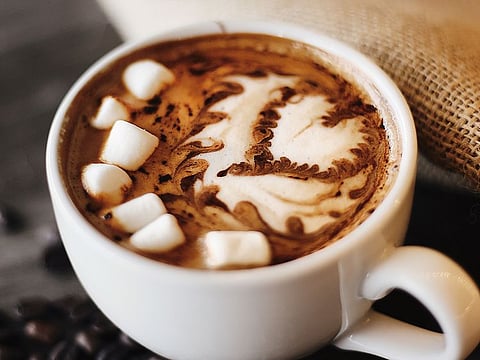A warm cup of hot chocolate for UAE winters
Not all chocolate drinks are hot chocolate. Here is a recipe to try

Dubai: It’s winter, officially. Imagine sitting on a couch with a book in hand and sipping a warm cup of hot chocolate. But how will you know if it’s authentic hot chocolate or just cocoa masquerading as one? Gulf News Food team takes you on a journey to understanding hot chocolate.
Who drank hot chocolate first?
Hot chocolate was a bittersweet beverage, sprinkled with a dash of cayenne pepper and served at room temperature for most of its history. Edible chocolate bars or edible sweet chocolates that we consume today came much later.
Chocolate is derived from cocoa beans found inside melon-like pods that grow on tall trees about 40 to 60 feet tall. The trees are botanically called Theobroma cacao. They are grown in Central America, South America, Africa, and Indonesia.
The word chocolate is derived from the Mayan word xocoatla, and the phrase chocolat is a combination of two words where Choco means foam and atl implies water. This etymology denotes that chocolate was first consumed as a beverage and only much later considered edible.
Food historians have traced the origin of chocolate to the Olmecs, one of the earliest known Mesoamerican civilisations in Central America. Making hot chocolate and adding chilli powder dates back to 500 BC when Mayans made this drink from ground cocoa seeds. The cocoa was first made into a paste, to which water, corn starch and cayenne pepper were added. It was the Mayans, who first made and drank hot chocolate.
Know your hot chocolate from cocoa
Have you ever wondered why the picture of the hot chocolate you have seen and the one you ordered does not match? It is probably because you ordered hot cocoa. This drink is made with powdered cocoa, milk, sugar and has a thinner consistency. Whereas authentic hot chocolate is richer and denser because it uses molten chocolate. It also has bittersweet notes depending on the percentage and type of cacao (cacao refers to cacao beans that have not been roasted, whereas cocoa is made of beans that have been roasted) used as a base. So, the next time you order a hot chocolate, ask the barista if they use cocoa powder or molten chocolate and check the cocoa percentage they use too.
However, if you invite friends over for a cup of hot chocolate and decide to make it yourself, follow a few rules. The best way to use chocolate, whether eating chocolate chips, shaved chocolate or bars, is to first melt them using a double boiler method or bain-marie. Also check if the chocolate you are using is for cooking or direct consumption. They both have different melting points.
In this method, the steam of the simmering water gently melts the chocolate. This gives you control over the heat. And the best way is to use a stovetop. A word of advice, do not melt chocolate in a microwave, because you don’t want to burn your chocolate. Also, it tastes different upon melting this way.
Once you have your chocolate ready, slowly mix it with warm milk. To finish, simply add a dash of fresh cream or whipped cream and sprinkle the desired flavouring. Like cinnamon? Sprinkle some. Have leftover marshmallows? Dip it in or just add a dash of cayenne pepper and drink it like the Mayans did.
Hot chocolate and its different names
The name of this hot beverage varies from country to country. In Latin America, this beverage is called spiced chocolate para mesa, cioccolata calda in Italy and chocolate a la taza in Spain. A much thinner and sweeter version - hot cocoa is consumed in the United States. The taste of chocolate varies across different continents. For example, European chocolate tends to have more cocoa content, whereas American chocolate has more milk and sugar.
If you have read Joane Harris’s book – chocolat or seen the movie starring actor Johnny Depp based on this book, you will know the magic of adding a dash of red chilli flakes to a thick creamy mug of hot chocolate. The story is set in a fictional rural French village called Lansquenet-sous-Tannes. The protagonist – Vianne Rocher, a young single mother, is a traveller, and when she arrives in this village, she decides to open the first chocolaterie - La Céleste Praline. Much to the surprise of the residents, she gains popularity. The one drink that makes her famous is her hot chocolate. Her not-so-secret trick to making this drink was using a dash of cayenne pepper to balance the sweetness. Putting things in perspective, this bittersweet drink symbolises the nature of life.
Here is a recipe using Valrhona chocolate:
100 gms fresh cream
250 gms milk
75 gms eating chocolate
Combine milk and sugar in a small saucepan and place on the stovetop over medium heat.
Melt the chocolate using a double boiler method. Stir the chocolate. Continue to heat and stir the chocolate in 30 second intervals until melted.
When the milk reaches the scalding point, that is bubbles begin to form on the sides, turn off the heat and add the melted chocolate, whisking to combine. Add any flavour you would like, cinnamon or vanilla. Top with whipped cream or marshmallows, sit back and enjoy.
Recipe courtesy: Chef David Croiser, owner David Croiser bakery, Dubai
Sign up for the Daily Briefing
Get the latest news and updates straight to your inbox




